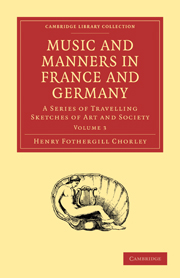CHAP. I - THE OPERA AND ITS ENVIRONS.—1839
Published online by Cambridge University Press: 29 August 2010
Summary
The railroad travelling of Germany has features which are all its own. In England you are whirled along with an irresistible rapidity which entirely precludes the possibility of thought, or conversation, or enjoyment. The journey is a disagreeable, bewildering dream, made up of several blasts of the shrill steam-whistle — a few tunnels — a few broken clamours, timid or troublesome, of passengers on their entrance and exit — perhaps a few broken limbs, — the best part of which is its close. In Belgium there is more to observe: rich farms, stately belfries embroidered with tracery and ornament, are to be seen as you are swept — more leisurely than at home — from one town to another. But there is an amount of confusion and uncertainty which keeps the mind anxious. So many lines meet and diverge, and so awkwardly is the transmission of baggage managed, that it is seven chances to one but, while you are upon your road to the Rubenses at Antwerp, your “mails” may be scouring along the rails to Ans (Liege). Hood's story of the bewildered lady, strong in her own foresight, who spent the day in travelling backwards and forwards betwixt Ghent and Ostend, owing to the want of her proper understanding, and her own prudence “in never getting out,”—is hardly a caricature. But betwixt Leipsic and Dresden no such whimsical casualties can happen.
- Type
- Chapter
- Information
- Music and Manners in France and GermanyA Series of Travelling Sketches of Art and Society, pp. 131 - 161Publisher: Cambridge University PressPrint publication year: 2009First published in: 1841



